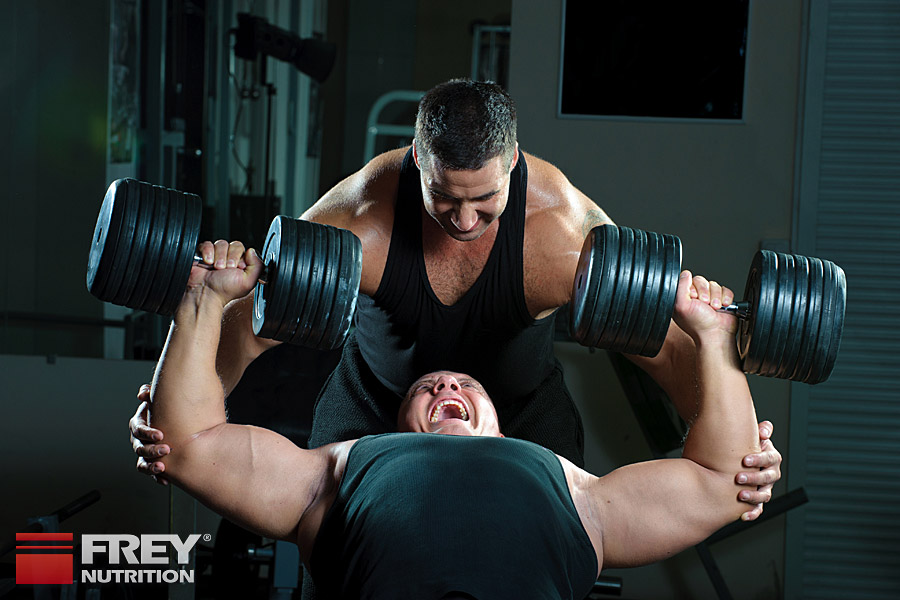THE BASICS OF EFFECTIVE TRAINING
The following principles are considered the basis for targeted, meaningful and successful training, which are also observed by HIT and apply to both men and women:
THE 7 BASICS OF EFFECTIVE TRAINING
- HIGH INTENSITY!
- EVERY SET UNTIL MUSCLE FAILURE!
- TRAINING DURATION MAXIMUM 60 MINUTES!
- 10 SETS FOR LARGE & 6 SETS FOR SMALL MUSCLES
- AVERAGE 8 TO 12 REPS!
- EXPLOSIVE AND EMPHASISLY NEGATIVE!
- CLEAN AND CONTROLLED MOVEMENTS!
1. HIGH INTENSITY!
High intensity means maintaining consistent rest periods between sets and a number of repetitions of 6 to 12. This means that when you reach 12 repetitions, the weight in the next training session should be increased by 2.5 to 5 kg, depending on the exercise. Maintaining rest periods between sets is extremely important for maintaining intensity, as a break that is too short can reduce the strength output in the next set, thereby disrupting the stimulus for muscle growth.
A break that is too long, however, can reduce blood flow to the muscles, the trained muscle becomes cold and the susceptibility to injury increases rapidly. The optimal recovery time between 2 sets should therefore be 1 to 3 minutes. When training your legs, this can be increased to 4 to 5 minutes if necessary due to the extreme strain on the cardiovascular system. If you want to significantly increase the intensity of your training, you should halve the break time in your next training session. The training will not be pleasant, but at the latest then you will notice what intensity means.
WHAT IS A FUN NIGHT FOR THE BOYS IS PURE POISON FOR TRAINING.
Anyone who thinks they can measure and maintain the time between two sets according to their own perception is seriously mistaken. Humorous distractions from sociable training colleagues often lead to diversion and quickly lead to double-digit break times, which means that training injuries are inevitable. You will hardly be aware of this unwanted extension of the break time as the fun distraction has made the time pass more quickly. What is a basic requirement for a fun guys' evening is, however, pure poison for training. If, on the other hand, you train completely alone without any distractions, the recovery times that are too short can hinder optimal strength performance. Due to the problem described, a stopwatch should be used with which you can reliably and precisely measure the time between two sets.
2. EVERY SET UNTIL MUSCLE FAILURE!
Muscles need a stimulus to grow, because only then can they prepare themselves by building new structures in order to be able to cope with the strain in the next training session.
It is therefore important to go to muscle failure in each set, ie to complete so many repetitions that no more clean repetitions are possible. The greatest training stimulus is achieved in the last repetitions of a set in particular, and this lays the foundation for muscle building.
3. TRAINING DURATION MAXIMUM 60 MINUTES!
The length of a training session should be limited to a maximum of 60 minutes. The reason for this recommendation is, on the one hand, the consideration of our body's hormonal control circuits and, quite simply, the loss of concentration. After 60 minutes, further repetitions and sets are possible, but they cannot be performed intensively and with maximum concentration. Anyone who still believes this is wrong and does not notice it or does not want to notice it, depending on whether appeasing one's own conscience is a goal...
Paying attention to hormonal processes in the body is the basis for effective training due to the scientifically proven fact that our organism releases increased amounts of cortisol after about 60 minutes of intensive exercise.
"OPTIMAL TRAINING ENDS EXACTLY WHEN THE RISK OF CORTISOL RELEASE IS GREATEST. THE MAXIMUM IS 60 MINUTES!" (QUOTE: A. FREY
Cortisol is considered a highly catabolic hormone in our body, is a strong anti-inflammatory and is mainly produced in stressful situations. Training sessions that last too long are precisely such stressful situations. After it is released, cortisol uses muscle substance as energy, which leads to muscle breakdown. Therefore, optimal training should end precisely when the risk of cortisol release is greatest and could occur. A training session should therefore not be longer than 60 minutes to achieve optimal results. The often practiced practice of three-hour training, in which the proponents have fallen into the false belief that a long training session would result in huge mountains of muscle, has no basis in training. In fact, the opposite will be the case in the form of muscle breakdown.
4. 10 SETS FOR LARGE & 6 SETS FOR SMALL MUSCLES
An effective training session should consist of a maximum of 10 sets for large muscles and a maximum of 6 sets for small muscles. Large muscles are the chest muscles, shoulder muscles, back and leg muscles. The small muscles of the body include biceps, triceps, calves and stomach.
Exceptions to this rule are warm-up sets, which are generally not included in the training sets. These only serve to warm up the muscle group to be trained and only place minimal strain on the muscles. Anything over 6 or 10 sets is usually a waste of time and can reduce the desired muscle building, for the reasons explained in the last part. If the recommended sets are performed with the highest intensity and maximum concentration, it is biologically impossible to complete further sets with the same intensity and concentration.
5. AVERAGE 8 TO 12 REPS!
8 to 12 repetitions are the optimal range in both the build-up and diet phases. For more advanced athletes, the holistic training principle with a comprehensive repetition range of six to 50 can be useful (see: INTENSITY TRAINING ).
If 12 repetitions are achieved in a set, the training weight is increased by 2.5 to 5 kilos the next time to ensure a stronger stimulus and continuously stimulate muscle building.
6. EXPLOSIVE MOVEMENT WITH NEGATIVE EMPHASIS!
The key to effective repetition is an explosive upward movement, followed by a slow downward movement, which is also known as a negative movement. This negative movement is the basis of the intensity technique of negative repetitions and is extremely important for "normal muscle soreness". Contrary to the common view that muscle soreness is bad for muscle building, new scientific findings have revealed some interesting facts.
MUSCLE SORENESS IS AN INDICATION OF INTENSIVE TRAINING AND IS FUNDAMENTALLY INVOLVED IN MUSCLE BUILDING.
Even the smallest injuries and extreme stretching of the muscles can cause muscle soreness. This is largely beneficial for muscle building, as the subsequent infiltration of lactic acid into the trained muscles is accompanied by an increased release of growth hormone. This growth hormone release, which is important for muscle building, is greatly promoted by the negative movement of a repetition. The slightly pumped-up feeling of the trained muscles the day after a training session is an indication of such an accumulation of lactic acid. Muscle soreness is therefore evidence of intensive training and, through the forced release of growth hormone, is fundamentally involved in muscle building.
However, extreme muscle soreness accompanied by severe pain should always be avoided. In this case, the muscle tears and damage caused by training were too great for sufficient recovery to occur before the next training session, which is why a longer recovery time is required. The negative movement of a repetition represents a very unusual strain on our body, especially since it is almost exclusively confronted with positive movements. This is why our body reacts particularly well to negative repetitions by building muscle. Based on this, the explosive upward movement with a cadence of 1 to 2 seconds and the subsequent negative movement of 3 to 4 seconds is the basis of effective training and is therefore recommended.
7. CORRECT AND CONTROLLED MOVEMENT EXECUTION!
Everyone should be aware of the importance of performing the exercise correctly without cheating; however, there are many athletes who seriously disregard this crucial basic rule. The belief that lifting heavy weights without paying attention to correct execution will lead to massive muscles is usually the motivating goal of these training beginners. This approach often leads to injuries and a subsequent termination of training. It cannot be emphasized enough how important it is to perform the exercise correctly. This puts much more strain on the muscle fibers and effectively prevents injuries.
If you often train with heavy weights and prefer free weights, you should definitely get support from a training partner before heavy sets. This partner should ensure that the movement is smooth and clean, especially during the last repetitions, but should not provide minimal assistance for more than the last two repetitions; just enough to move the weight slowly and evenly into the end position of a repetition.
All too often you see people training on the flat bench, with the person helping you pulling so hard on the bar and trying to support their training buddy that you might think one is training his chest muscles and the other his back muscles at the same time. What might look funny is of course anything but fun or useful and increases the risk of injury enormously, in this case for both strength athletes.
YOU SHOULD NOT BELIEVE EVERYTHING YOU HEAR!
If you ask 100 different people, you will get 100 different opinions - but you shouldn't believe everything you hear! It's more important to separate the wheat from the chaff, because some self-proclaimed fitness gurus don't necessarily have the wisdom they want us to believe. You can and should rely on athletes with practical experience who have many years of training and/or competition experience. Because it is only in practice that you can see what the theoretical foundations are really worth, and the most promising theory is of little use if it doesn't work out in practice. And that's exactly why the 7 training principles described here are very practice-oriented, because winning is not done on paper, but on stage!
Anyone who observes these principles (which are also FIT Anyone who uses the same principles (the basis for this) is well on the way to achieving their training goals. Every day, new groundbreaking training techniques are introduced that are intended to be sold to men and women. You should generally be very skeptical about these and not try out everything that is spread through the print media and/or training partners. Because many of the newly advertised "extreme" techniques promise a lot, but not only do not deliver, but can also seriously endanger training success by causing overtraining and injuries.
Even though the genetic makeup of each individual is different, the elementary biological processes remain the same and since every single training basis takes the biological processes of the human body into account, most athletes respond to them with astonishing success. And that is precisely why we are not promising anything here that cannot be kept later, but are only teaching the basics that will lead to long-term and measurable success!













